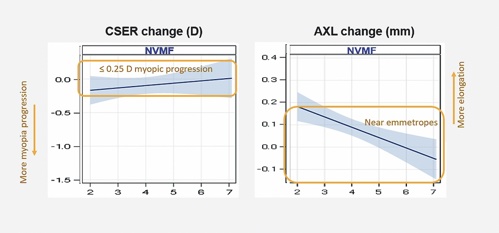Visioneering Technologies Inc. (VTI) is continuing its PROTECT trial to provide data regarding the role of its NaturalVue® Multifocal 1 Day (NVMF) contact lens in controlling the progression of myopia in children. Results to date indicate that the catenary power curve of the NVMF lens design is effective toward that goal, particularly as it relates to working within the smaller pupil size of children.
Typical optical designs for myopia progression control (MPC) usually provide around 2 D of relative plus (ADD power), whereas the NVMF, due to the catenary power curve, reaches 2 D rapidly, and continuously increases the relative plus to deliver 6 D to 8 D ADD inside the average pupil diameter for children.1,2
At the one-year mark, results are promising.
Trial Data
The trial, which recently completed its first year, is a three-year multinational, double-masked, randomized controlled trial evaluating the effectiveness and safety of these lenses for MPC in children.
• Control: Single vision contact lens (NaturalVue Sphere)
• Treatment: Catenary power curve contact lens
(NaturalVue Multifocal)
The primary outcome measures are a change of cycloplegic spherical equivalent autorefraction (CSER) and a change of axial length (AXL).
The trial involved 145 subjects from Canada, the United States, Hong Kong, and Singapore with the average age of 9.9±1.5 and CSER of -2.4±1.3 at enrollment.
Having passed the one-year mark, a planned interim analysis of the trial was carried out.
A planned subgroup analysis was carried out to allow better meta-analysis in the future. Subgroup ages 8 to <13; CSER -0.75 to -4.00 D. NVMF had adjusted values of 0.48 D (89%) reduction of myopia progression, and 0.17 mm (58%) reduction of axial length. Adjusted treatment effects equalize other factors (such as age, sex, pupil size and study site) that may influence myopic progression. Removing these factors may make adjusted results a better statistical representation of the actual effect of the intervention being studied. (Reference: Akerman D., Editor’s Perspective. Review of Myopia Management, September 2024.)
It was reported that myopic children tend to have smaller pupils.3 PROTECT found a large majority of subjects with indoor photopic pupil size from 2 mm-7 mm to be near emmetropic. (Figure 1)
Multiple real-world studies have previously demonstrated effectiveness for myopia management using this design.4-6
Across real-world and randomized control trial studies, a large majority (71%-95%) of children, with astigmatism as high as 1.75 D, wearing the NVMF experienced myopic progression of ≤0.25 D per year. In addition, minimal progressions (≤0.25 D) were reported in the following year as well.

Key Conclusions
While there are differences between retrospective studies and randomized controlled trials, analyzing and correlating their trends provides valuable insight into the consistency in the performance of this catenary curve-based contact lens under different practice settings.
A large majority of children (with up to 1.75 diopters of cylinder [DC]) wearing the catenary power profile contact lenses experienced CSER change of ≤0.25 D/yr, regardless of the wearer’s pupil size.
“What the data from this study is showing is that the catenary curve-based multifocal contact lens is effective for a large range of pupil sizes, and can likely continue benefitting the children during prolonged outdoor lighting exposures [when they have] more constricted pupil sizes,” notes K. Ashley Tuan, OD, PhD, FAAO, Chief Medical Officer of VTI. “Though PROTECT is ongoing, we believe it is indicating that NVMF may be safe and effective in slowing myopia progression in diverse clinical settings, populations, and pupil sizes.”
REFERENCES
1. Connelly M, Neville K, Developmental Changes of Normal Pupil Size and Reactivity in Children. J Ped Ophthal Strab. May 2015. doi:10.3928/01913913-20150317-11
2. Silbert J, et al. Pupil size and anisocoria in children measured by the plusoptiX photo screener. J AAPOS. 2013;17:609-611.
3. Xu S, Li L, Han W, et al. Association Between Myopia and Pupil Diameter in Preschoolers: Evidence from a Machine Learning Approach Based on a Real-World Large-Scale Dataset. Ophthalmol Ther. 2024 Jul; 13(7): 2009-2022. doi: 10.1007/s40123-024-00972-5
4. Cooper J, O’Connor B, Aller T, et al. Reduction of Myopic Progression Using a Multi-focal Soft Contact Lens: a Retrospective Cohort Study. Clin Ophthalmol. 2022 Jul 4:16:2145-2155. doi: 10.2147/OPTH.S370041
5. Cooper J, Aller T, Smith E, et al. Retrospective Analysis of a Clinical Algorithm for Managing Childhood Myopia Progression. Optom Vis Sci. 2023 Jan 1;100(1):117-124. doi: 10.1097/OPX.0000000000001978.
6. Lederman C. Myopia Control with Extended Depth of Focus Multifocal
Contact Lenses, American Association for Pediatric Ophthalmology and
Strabismus conference abstract, March 29-April 2, 2023, New York, NY.
THIS CONTENT IS SPONSORED BY




